Evan Turner, Philadelphia
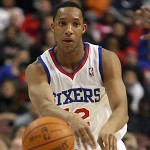 Like fellow second overall pick Williams, the 2010 version Turner is facing long odds in returning to his team next season. Turner’s production just doesn’t match the value of his contract ($6.68 million this season, $8.7 million qualifying offer next summer). And the arrival of new ownership and management could lead to his departure from the rebuilding 76ers.
Like fellow second overall pick Williams, the 2010 version Turner is facing long odds in returning to his team next season. Turner’s production just doesn’t match the value of his contract ($6.68 million this season, $8.7 million qualifying offer next summer). And the arrival of new ownership and management could lead to his departure from the rebuilding 76ers.
Turner averaged a career high 13.3 points in 35.3 minutes last season. But his field goal percentage was a career-low 41.9 percent. His 3-point percentage was a very healthy 36.5 percent, but he took just 1.9 treys per contest. He averaged 6.3 rebounds and 4.3 assists but played way too many minutes for a team that just didn’t (and still doesn’t) have a lot of talent.
To put it mildly, Turner’s advanced stats weren’t very good.
| Turner Advanced | PER | TS % | EFG% | O Rtg | D Rtg | O WS | D WS | WS | WS/48 |
| 2011-2012 | 12.6 | 47.8 | 45.5 | 93 | 99 | -0.6 | 3 | 2.4 | 0.068 |
| 2012-2013 | 12.1 | 47.8 | 44.6 | 95 | 106 | -0.7 | 2.9 | 2.1 | 0.035 |
To make matters worse, Turner regressed for the most part from 2011-2012. He was less efficient in every single advanced measure but offensive rating and was still absolutely abysmal in that department. He’s a negative player on offense and still a below-average player overall.
Barring an unexpected career resurgence and renaissance and given new GM Sam Hinkie’s desire to totally rebuild the roster, Turner will be looking for another team next summer. Whether he will make half of what he’s going to get this coming season is ultimately up to him.
Spencer Hawes, Philadelphia
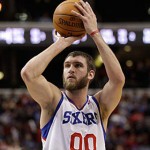 There’s a pretty good chance that Hawes won’t make $6.5 million per season after the 2013-2014 campaign. Following his best statistical season in 2011-2012, Hawes took a step back in a few areas last season. He wasn’t nearly as efficient, dropping in PER and Win Shares per 48 minutes, but did put up career highs in Win Shares, scoring (11 ppg) and blocks (1.4 bpg) while averaging over seven rebounds.
There’s a pretty good chance that Hawes won’t make $6.5 million per season after the 2013-2014 campaign. Following his best statistical season in 2011-2012, Hawes took a step back in a few areas last season. He wasn’t nearly as efficient, dropping in PER and Win Shares per 48 minutes, but did put up career highs in Win Shares, scoring (11 ppg) and blocks (1.4 bpg) while averaging over seven rebounds.
Hawes is just 25, but this coming season will likely determine his career trajectory. Will he get any shot at a starting role going forward – he started 40 of 82 games last season – or will he be a career backup?
Hawes will be a placeholder for Nerlens Noel, who will likely start soon after returning around January from his ACL tear. That could end up being his permanent role for whichever team he ultimately plays for down the line. Is Hawes anything more than that? He has this season to prove it.
Royce White, Philadelphia
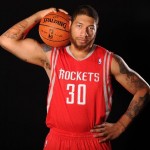 White needs to play. Somewhere. Seriously. He played just 16 games for Houston’s D-League team last season and got into numerous arguments and squabbles with Rockets management on accommodating his anxiety disorder with medical care and travel arrangements. White made a lot of noise and a lot of news, and none of it was for his play.
White needs to play. Somewhere. Seriously. He played just 16 games for Houston’s D-League team last season and got into numerous arguments and squabbles with Rockets management on accommodating his anxiety disorder with medical care and travel arrangements. White made a lot of noise and a lot of news, and none of it was for his play.
Houston had enough and – needing the cap space to sign Dwight Howard – shipped White to Philadelphia in a low-risk deal for the Sixers. Philadelphia will pay White, 22, just over $1.7 million this season to try to get any kind of tangible value out of someone who showed real ability as a complete player at Iowa State.
NBA teams don’t really like distractions very much, and White has been nothing but that during his brief career. The Sixers holds a $1.8 million team option on White in 2014-2015 that must be picked up in October, and it’s not a stretch to say that White may not get another shot in the league if he doesn’t show a significant attitude adjustment this season.
Kyle Lowry, Toronto
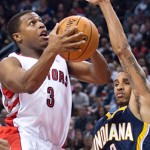 There’s no question the Raptors have some interesting talent, but we have no clue what their overall plan may be. GM Masai Ujiri was hired at the beginning of the offseason and masterfully sent Andrea Bargnani to the Knicks and signed former Pacers Tyler Hansbrough and D.J. Augustin to beef up the bench. Rudy Gay, DeMar DeRozan and Jonas Valanciunas comprise the long-term core of this team.
There’s no question the Raptors have some interesting talent, but we have no clue what their overall plan may be. GM Masai Ujiri was hired at the beginning of the offseason and masterfully sent Andrea Bargnani to the Knicks and signed former Pacers Tyler Hansbrough and D.J. Augustin to beef up the bench. Rudy Gay, DeMar DeRozan and Jonas Valanciunas comprise the long-term core of this team.
So where does Kyle Lowry fit in?
Lowry will make $6.21 million in the last year of his contract, and his future with Toronto is far from certain. Based on Gay’s salary, it seems like he is going to be on this team for another two years no matter what. And since the Raptors acquired Gay at the end of January, Lowry’s offensive play suffered.
| Lowry | Minutes | FG % | 3 FG % | Points | Reb | Ast |
| January | 24.0 | 41.0 | 46.3 | 10.5 | 3.6 | 5.6 |
| February | 32.8 | 39.1 | 41.2 | 11.3 | 4.4 | 6.5 |
| March | 31.1 | 38.7 | 31.1 | 9.1 | 5.2 | 6.3 |
| April | 31.0 | 37.3 | 24.2 | 9.6 | 4.7 | 8.6 |
Lowry’s transition to a quasi-distributor is admirable, but his shooting percentages sunk to unacceptable lows toward the end of the season. Gay’s first game with the Raptors was on Feb. 1, and Lowry initially played really well with him. But for some reason, Lowry’s play really sagged in March and April.
If that’s a sign of things to come, it is hard to imagine Lowry remaining with the team assuming Toronto can’t trade Gay. It’s a big season for Lowry as Ujiri slowly remakes the roster.
Gordon Hayward, Utah
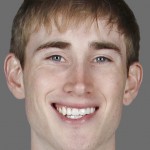 If you hadn’t realized, Utah was really focused on rebuilding and shedding salary this summer. We’ll leave the T word for another column. But with Enes Kanter, Derrick Favors and rookie Trey Burke forming the nucleus of the Jazz’s rebuilding plans, there is certainly an opportunity for Hayward to be a large part of the team’s long-term vision.
If you hadn’t realized, Utah was really focused on rebuilding and shedding salary this summer. We’ll leave the T word for another column. But with Enes Kanter, Derrick Favors and rookie Trey Burke forming the nucleus of the Jazz’s rebuilding plans, there is certainly an opportunity for Hayward to be a large part of the team’s long-term vision.
Hayward is eligible for an extension, but if he doesn’t get one, he will be a restricted free agent next summer. He could be in for a nice pay raise if he continues his progression.
He took and hit more threes last season, converting on 41.5 percent of his triple tries, to go with a career-high 14.1 points per game. That scoring average could easily increase with Al Jefferson and Paul Millsap no longer in the mix, and given his experience compared to his teammates, he could be Utah’s top offensive option.
It’s really an open competition to see who emerges as the leader of this new, youthful Utah squad. Hayward can either leave his mark on the team or find himself marginalized elsewhere come next summer.
Shlomo Sprung loves advanced statistics and the way they explain what happens on the court. He is also the web editor of the Brooklyn Daily Eagle. A 2011 graduate of Columbia University’s Journalism School, he has previously worked for the New York Knicks, The Sporting News, Business Insider and other publications. His website is SprungOnSports.com. You can follow him on Twitter.
When a relatively young player puts up offensive numbers like Collison and only receives a one year deal for just $1.9 million there is a lot more to it than just stats. Most likely Collison has issues maybe with teammates or coaches. Very possibly Collison has developed a reputation around the league as a negative influence. In any case hopefully Doc will make sure Collison will not mess up the Clippers team chemistry.